The bats are out of the belfry and terrorizing Australians.
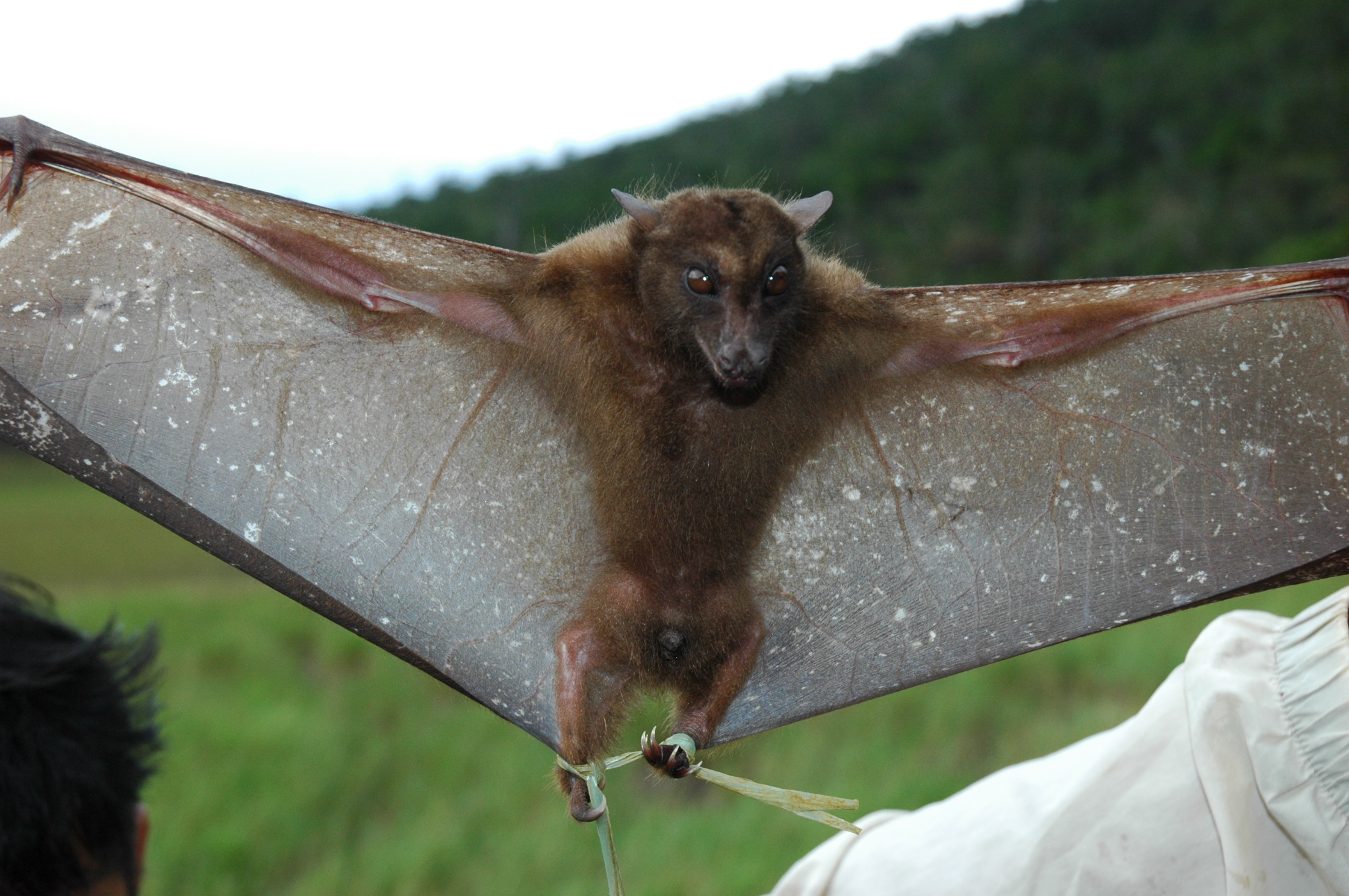
Tens of thousands of the menacing mammals are frightening the residents of Ingham, Queensland, with their looming presence, reported news.com.au.
The massive fruit bat colony has been hovering over the town of 4,300 for days now.
The fearsome flock has swooped in on the town’s botanical gardens and is perched in trees near schools.
Even more worrisome for residents is that the colony appears to be expanding.
“It’s like a bat tornado over the town,” explained resident Adam Kaurila, who is considering yanking his two daughters out of school over bat exposure and scratch alarms.
The biggest concern when it comes to bat bites and scratches is lyssavirus, a disease similar to rabies.
Three cases have been confirmed Down Under — all fatal.

Kaurila’s wife also expressed apprehension for her kids’ safety.
"They’re not stepping a foot in that ground until something is, we know that is, being done, said his wife, Susanne.
Bats are a protected species under Queensland law, meaning the city council is limited in how it can manage them.
While nonlethal methods such as noise, smoke and light are effective deterrents, they can’t be utilized while the bats are breeding, according to news.com.au.
In Charters Towers — located about 150 miles southwest of Ingham, residents there are also coping with a severe bat problem.

One Aussie politician says enough is enough.
“There comes a point where I think breaking the law really becomes ‘dogging it,’ as we say in North Queensland,” said state representative Bob Katter. “And I think that point has probably been reached.”
WHICH RESULTS IN THIS Rare flying foxes shot in 'horrific' Australia attack
---30---
SEPTEMBER 24, 2019
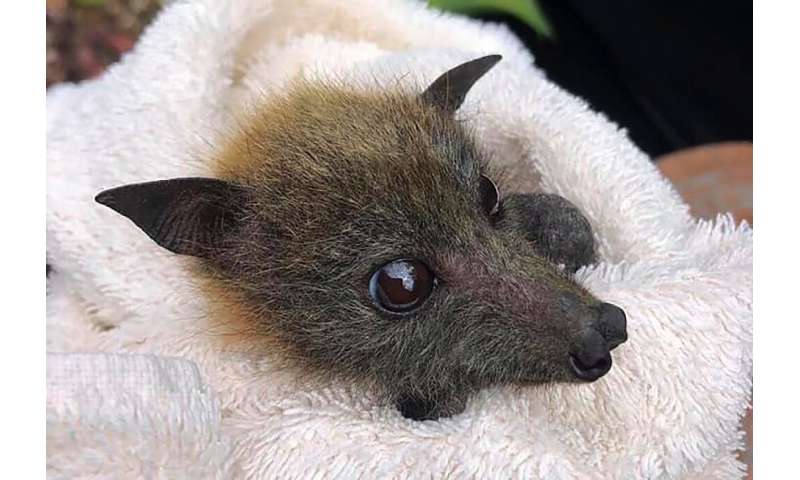
A fruit bat rescued from drought by Queensland Bats is nursed back to health at their wildlife centre on Australia's Gold Coast
Large numbers of bats are being found severely emaciated or starved to death in Australia amid a prolonged drought that is crippling their food supply, according to wildlife carers and environment officials.
There has been a "rapid increase" in the number of stricken native flying foxes found in areas of Queensland and New South Wales over the past two weeks, rescue group Bats Queensland told AFP.
Volunteer wildlife carer Ashley Fraser said Tuesday that parts of the picturesque Gold Coast, a popular tourist destination, were currently "littered" with hundreds of dead bats.
Though there have been cases of mass bat starvation in the region before, Fraser said her organisation had never dealt with an event on this scale.
"We can expect to see it get worse as well," she told AFP.
"The changing climate is going to worsen the drought and make it a pretty poor environment for bats to try to survive in."
Some flying fox species are listed as vulnerable to extinction. They are also a key pollinator of eucalyptus trees, the koala's main food source.
Queensland's Department of Environment and Science told AFP that officials believed the deaths were linked to the impact on the bats' food supply of the extended drought, as well as recent bushfires and storms.

Large numbers of bats are being found severely emaciated or starved to death in Australia amid a prolonged drought that is crippling their food supply, according to wildlife carers and environment officials.
There has been a "rapid increase" in the number of stricken native flying foxes found in areas of Queensland and New South Wales over the past two weeks, rescue group Bats Queensland told AFP.
Volunteer wildlife carer Ashley Fraser said Tuesday that parts of the picturesque Gold Coast, a popular tourist destination, were currently "littered" with hundreds of dead bats.
Though there have been cases of mass bat starvation in the region before, Fraser said her organisation had never dealt with an event on this scale.
"We can expect to see it get worse as well," she told AFP.
"The changing climate is going to worsen the drought and make it a pretty poor environment for bats to try to survive in."
Some flying fox species are listed as vulnerable to extinction. They are also a key pollinator of eucalyptus trees, the koala's main food source.
Queensland's Department of Environment and Science told AFP that officials believed the deaths were linked to the impact on the bats' food supply of the extended drought, as well as recent bushfires and storms.

A fruit bat hangs in a cage at a rescue centre in Gold Coast, Australia
Fraser said many of the flying foxes rescued by Bats Queensland were so emaciated their bodies had begun shutting down beyond the point of repair, forcing carers to euthanise them.
Even for those deemed fit enough to survive up to seven weeks of rehabilitation, the future remains uncertain.
"We don't want to be releasing them if there's not the food sources out there," Fraser said.
All of New South Wales and two-thirds of Queensland have been declared as in drought, with the Bureau of Meteorology predicting below-average rainfall across much of Australia's east for the rest of the year.
Thousands of flying foxes died across Australia during the last southern hemisphere summer in a series of colony collapses caused by heat stress.
The increasingly common phenomenon is the result of extreme temperatures, which cause the bats to fall from trees as their brains boil and they succumb to the heat.
Fraser said many of the flying foxes rescued by Bats Queensland were so emaciated their bodies had begun shutting down beyond the point of repair, forcing carers to euthanise them.
Even for those deemed fit enough to survive up to seven weeks of rehabilitation, the future remains uncertain.
"We don't want to be releasing them if there's not the food sources out there," Fraser said.
All of New South Wales and two-thirds of Queensland have been declared as in drought, with the Bureau of Meteorology predicting below-average rainfall across much of Australia's east for the rest of the year.
Thousands of flying foxes died across Australia during the last southern hemisphere summer in a series of colony collapses caused by heat stress.
The increasingly common phenomenon is the result of extreme temperatures, which cause the bats to fall from trees as their brains boil and they succumb to the heat.
FRUIT BAT – FAMILY PTEROPODIDAE
DESCRIPTION
The Fruit Bat falls into the category of the Megabat and sometimes they are called the Flying Fox in some locations. There are many differences in their size from one location to the next. Due to that variation these bats are often mistaken for many different types rather than being identified as the same.
For example some Fruits Bats are no more than two inches long. Others though are more than 16 inches in length. Some of them only weigh an ounce or two and others weigh in at a couple of pounds. The overall wing length of the Fruit Bat can be more than five feet. These bats have large eyes and they also have excellent vision.
ANATOMY
In fact, the Fruit Bat is said to have the best overall vision of all bat species. They use their vision in conjunction with their sense of smell so that they are able to find their food sources. These senses also serve to help them avoid dangerous situations. They are a big type of bat and they are said to be among the most unique of the more than 1,200 species that have so far been identified.
The Fruit Bat have the best overall vision of all bat species.
The Fruit Bat has some sharp teeth that allow it to penetrate the skin of the fruits. They also have very long tongues that unroll when they are feeding. When they aren’t eating the tongue rolls back up. It is tucked away internally around the rib cage rather than remaining in the mouth.
The shape of the wings on Fruit Bats can be very different based on location. Many experts believe that this type of anatomy difference has to do with the fact that they live in different areas and have different types of fruit trees that they eat from. The wings may be certain designs to help compensate for wind and other elements in their natural environment.
In fact, the Fruit Bat is said to have the best overall vision of all bat species. They use their vision in conjunction with their sense of smell so that they are able to find their food sources. These senses also serve to help them avoid dangerous situations. They are a big type of bat and they are said to be among the most unique of the more than 1,200 species that have so far been identified.
The Fruit Bat have the best overall vision of all bat species.
The Fruit Bat has some sharp teeth that allow it to penetrate the skin of the fruits. They also have very long tongues that unroll when they are feeding. When they aren’t eating the tongue rolls back up. It is tucked away internally around the rib cage rather than remaining in the mouth.
The shape of the wings on Fruit Bats can be very different based on location. Many experts believe that this type of anatomy difference has to do with the fact that they live in different areas and have different types of fruit trees that they eat from. The wings may be certain designs to help compensate for wind and other elements in their natural environment.
EVOLUTION
Since most species of bats consume insects, the Fruit Bat is one that people are interested in. It is believed that they turned to eating in such a manner in order to help them survive. Circumstances could have warranted them deciding to consume a different type of food source in order to compensate for not enough insects being around.
The evolution process though is one which can be very complex. We simply don’t have enough information to make accurate determinations. Experts are hopeful though that one day they will find additional clues that put it all into perspective for them.
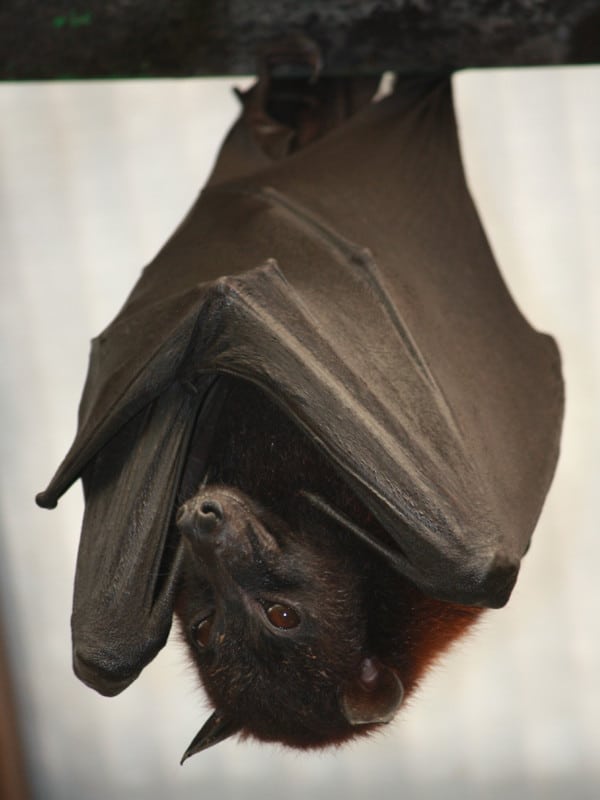
Fruit bat – Family Pteropodidae.
Since most species of bats consume insects, the Fruit Bat is one that people are interested in. It is believed that they turned to eating in such a manner in order to help them survive. Circumstances could have warranted them deciding to consume a different type of food source in order to compensate for not enough insects being around.
The evolution process though is one which can be very complex. We simply don’t have enough information to make accurate determinations. Experts are hopeful though that one day they will find additional clues that put it all into perspective for them.

Fruit bat – Family Pteropodidae.
BEHAVIOR
The very long wings of the Fruit Bat do much more than just allow it to fly. They also allow them to stay warm during roosting. They wrap up in those wings to conserve their body heat. They live in colonies that are very large in size because they feel safer with numbers.
Inside of each colony of Fruit Bats though you will find various sub colonies. Each of them has one male and approximately eight females. They form very close bonds with their sub groups.
HABITAT AND DISTRIBUTION
There are locations throughout the world where the Fruit Bat is able to successfully thrive. They tend to live in areas that offer them plenty of food. Where you find thick forest regions with lots of fruit trees, you can be confident they are in abundance. Most of them live in warmer climates where they can take advantage of various fruits that will grow throughout the year.
They may have to travel for long distances during certain times of the year in order to find food.
They may have to travel for long distances during certain times of the year in order to find food. They will make the journey back to their roost though before the sun comes up. Sometimes such efforts don’t leave the Fruit Bat much time at all to find lots of food though.
When the Fruit Bat roosts during the day, they do so high up in the trees. This gives them darkness and it also protects them from various predators. They may hide in crevices and other dark spaces as well. They will typically stay close to bodies of water.
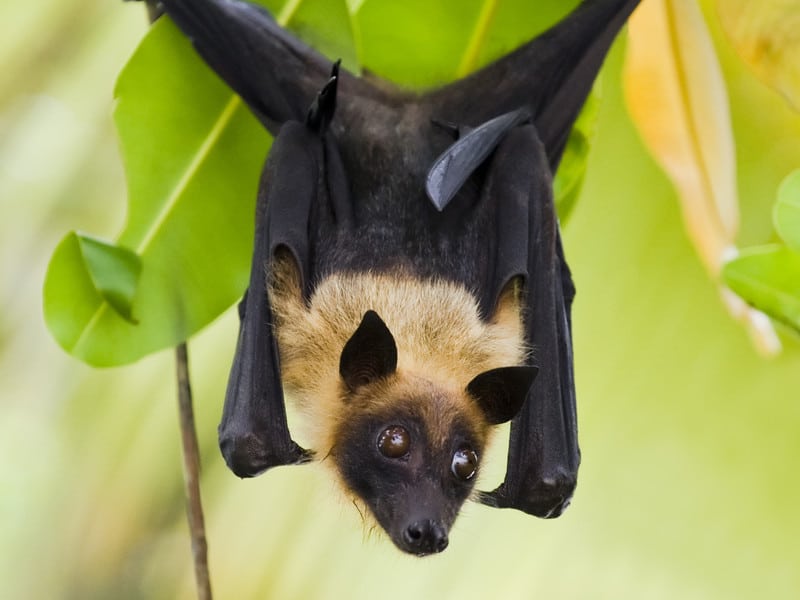
Indian flying fox – Pteropus giganteus.
DIET AND FEEDING HABITS
They use both vision and smell to find food.
There are hundreds of known types of fruits that grow on plants and trees that the Fruit Bat is able to consume. They don’t eat all of the fruit though like so many people believe that they do. Instead, they use their teeth to crush into the fruit. Then they will consume the nectar.
They use both vision and smell to find food. There is one known subspecies though that is believed to rely on echolocation to find their sources of food. With a Fruit Bat they can either linger in air and eat or they can land and eat it. The larger they are in size though the more difficult it is to consume food without landing first.
REPRODUCTION
Once mating has occurred they will carry the young in their bodies for about six months. The females will give birth to only one young at a time. It is going to be fully dependent upon her as the wings aren’t strong enough until they are six weeks old for flying.
The young will stay with their mother, even when she is out looking for food. They will cling to her body with claws that allow them to effortlessly remain in place. The Fruit Bat won’t take part in mating when they are struggling for habitat or to find food. It is believed this is a natural process for them that allows them to ensure overpopulation doesn’t occur in any given area where they live.
FLYING FOXES VIDEO!
httpvh://www.youtube.com/watch?v=oNHmz5Tq64g
PREDATORS
Due to the location where the Fruit Bar lives they don’t have too many natural predators. Sometimes they do encounter them though depending on their location. Various types of birds including the hawk and eagle can attack them while still in flight. Sometimes in the trees they may be eaten by snakes or weasels.
Sometimes in the trees they may be eaten by snakes or weasels.
In some areas the Fruit Bat lives very close to humans. Therefore it is possible for house cats to get them as well. In fact, some people don’t even know they have bats living in their trees until they end up finding their cat carrying one around with them.
Humans are also predators of the Fruit Bat. People that realize they have such creatures living in their trees take measures to get rid of them. These bats can get into the attic or other areas of the home as well. Usually a professional exterminator is called to remove them and to clean up after them.
Humans that want the fruit from these trees to themselves also don’t want the Fruit Bats around. However, it is important for humans to realize that the Fruit Bat helps to create more fruit by dispensing the seeds. When they fly around they will spit them out all over the place.
Due to the location where the Fruit Bar lives they don’t have too many natural predators. Sometimes they do encounter them though depending on their location. Various types of birds including the hawk and eagle can attack them while still in flight. Sometimes in the trees they may be eaten by snakes or weasels.
Sometimes in the trees they may be eaten by snakes or weasels.
In some areas the Fruit Bat lives very close to humans. Therefore it is possible for house cats to get them as well. In fact, some people don’t even know they have bats living in their trees until they end up finding their cat carrying one around with them.
Humans are also predators of the Fruit Bat. People that realize they have such creatures living in their trees take measures to get rid of them. These bats can get into the attic or other areas of the home as well. Usually a professional exterminator is called to remove them and to clean up after them.
Humans that want the fruit from these trees to themselves also don’t want the Fruit Bats around. However, it is important for humans to realize that the Fruit Bat helps to create more fruit by dispensing the seeds. When they fly around they will spit them out all over the place.
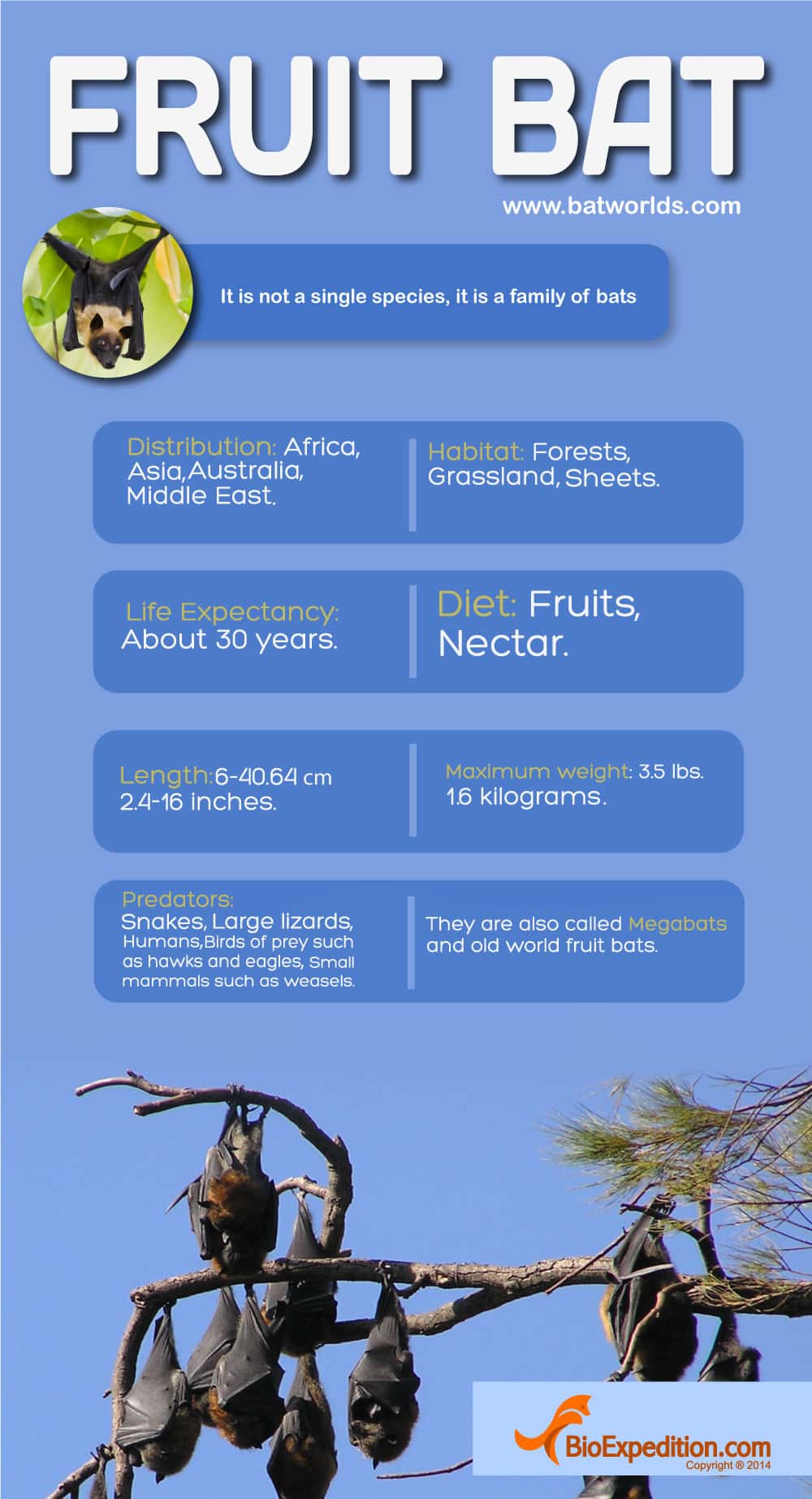
No comments:
Post a Comment